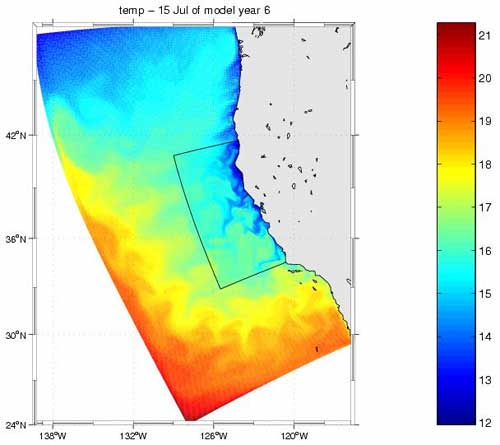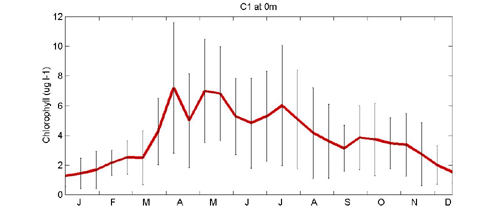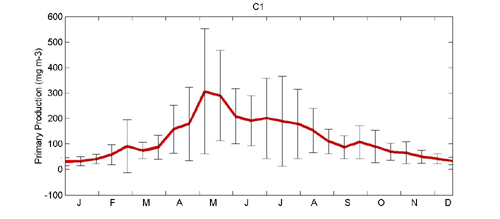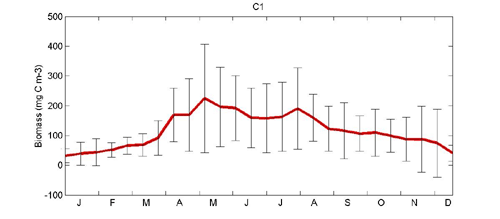- Strong offshore winds drive warmer surface water away from the coast which upwells colder water from below.
- Upwelling typically occurs from spring to late summer each year.
- Upwelled water is typically high in nutrients and produces a ‘bloom’ in phytoplankton growth.
- Large swarms of krill gather to feed on phytoplankton and attract fish, seabirds, and marine mammals who feed on the krill and or each other.
Windy days don’t only bring kites and sailboats to the Monterey Bay. Wind is one of the main reasons the Monterey Bay is such a rich ecosystem full of plankton, fish and home to many migratory species including whales and seabirds. From early spring to late summer, offshore and northwesterly winds drive the warmer surface water away from the coast allowing the colder water from below to rise up and replace it (Figure 1). The cold water from the deep lowers the overall sea surface temperature to about 50-55 degrees Fahrenheit and brings up nutrients like nitrates and phosphates that are otherwise trapped on the bottom in the form of decomposing organic material.
Phytoplankton, microscopic plants that form the base of the food chain in most of the ocean, ‘bloom’ from the upwelled nutrients by growing rapidly and reproducing in massive quantities. This plant growth, known as primary productivity (Figure 3), causes an increase in animal growth throughout the rest of the food chain. Zooplankton, such as krill, gather to feed on the abundant phytoplankton (Figure 4) and attract fish and whales who in turn feed on the krill. Seabirds and other marine mammals such as seals, sea lions, and porpoise are attracted to the fish and a complex web of producers and consumers is formed (Figure 5).
The upwelling season in Monterey Bay National Marine Sanctuary typically begins in March and ends around July. The effects of this seasonal occurrence can not only be seen in the marine organisms but in the weather as well. The traditionally foggy summers on the Central California coast are attributed to the physical interaction between the warm summer air and the newly upwelled cold ocean surface waters. As the cold surface waters cool the summer air, moisture collects and forms the coastal fog common to the Sanctuary.
Scientists have developed instruments and technology to detect upwelling at the level of the primary producers. One instrument, the fluorometer, detects pigments, primarily chlorophyll, that phytoplankton use to perform photosynthesis. Chlorophyll measurements (Figure 2) are used by oceanographers to determine the level of biological productivity throughout the food chain. Satellite imagery is used to detect pigmentation of the phytoplankton which reveals the quantity and distribution of phytoplankton over a given area of the ocean.
In the Monterey Bay National Marine Sanctuary there are research groups that are dedicated to collecting and analyzing information about the upwelling process. At UC Santa Cruz, the Center for Integrated Marine Technologies (CIMT) is collecting data on wind, primary productivity, krill, ocean temperature, seabirds, whales, and other components of the upwelling system. This data is analyzed and integrated to produce an enhanced understanding of the relationship between primary productivity and higher trophic level organisms such as fishes, marine mammals and seabirds.
The Monterey Bay Aquarium Research Institute (MBARI) also studies coastal upwelling in the Sanctuary. The Simulations of Coastal Ocean Physics and Ecosystems (SCOPE) project at MBARI assimilates data from satellites and ocean sensors to model the interconnected physical, chemical, and biological processes associated with upwelling. These models will help the Sanctuary manage the marine mammals, seabirds, and fish during a period of upwelling, as well as direct future research projects and observational efforts.
With so many marine organisms utilizing the upwelling process for food and reproduction, it is important that Monterey Bay National Marine Sanctuary staff understand the dynamics of this annual process in order to effectively manage these interconnected resources during this time of the year. Fortunately there are programs such as CIMT and SCOPE that are dedicated to enhancing the Sanctuary’s knowledge of this incredible oceanic phenomenon.
More information:
- UC Santa Cruz’s CIMT website – http://cimt.ucsc.edu/
- MBARI’s SCOPE webpage – http://www.mbari.org/bog/NOPP/
- Oceanography information on the SIMoN website – http://www.sanctuarysimon.org/monterey/sections/oceanography/overview.php?sec=o





